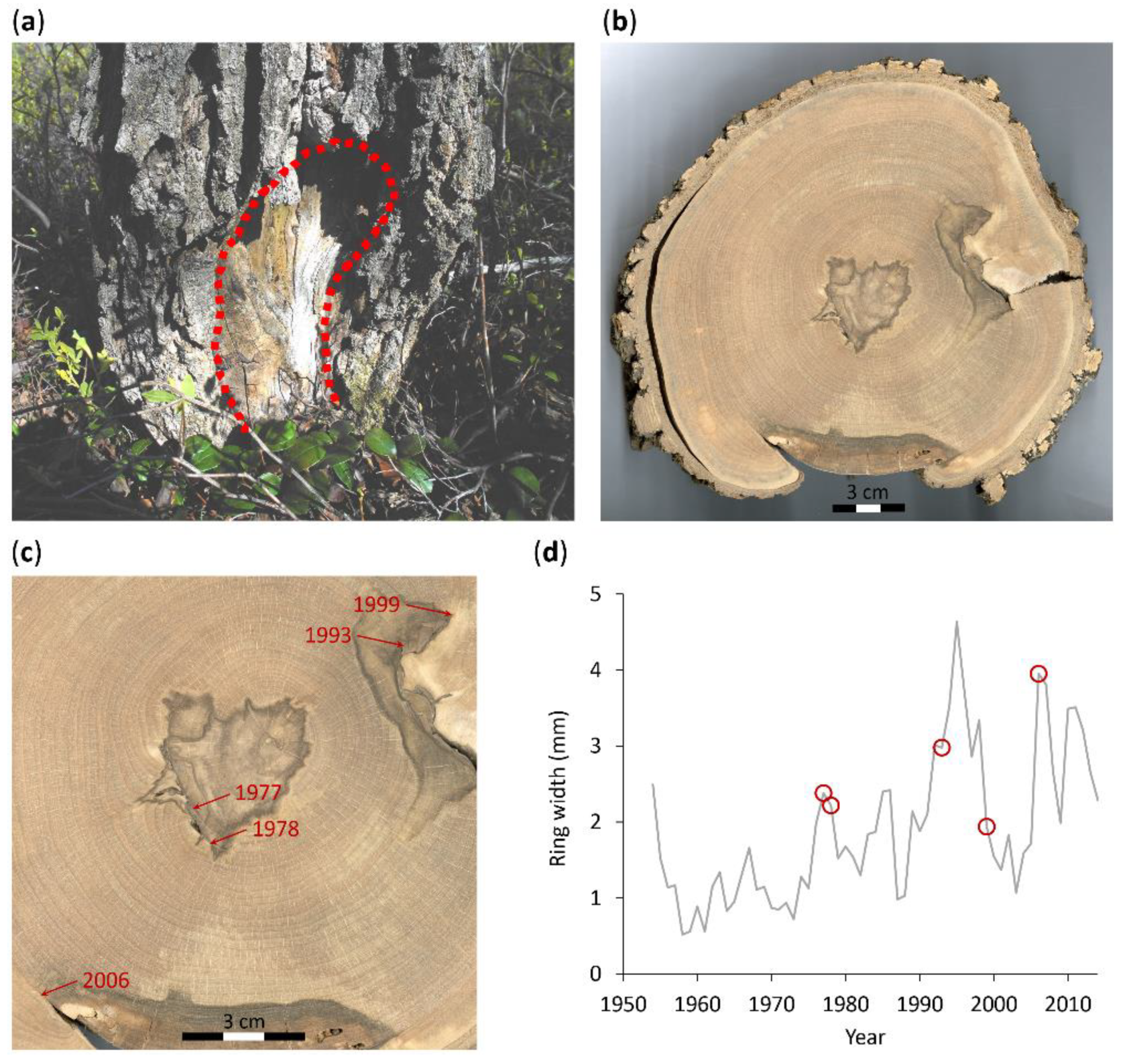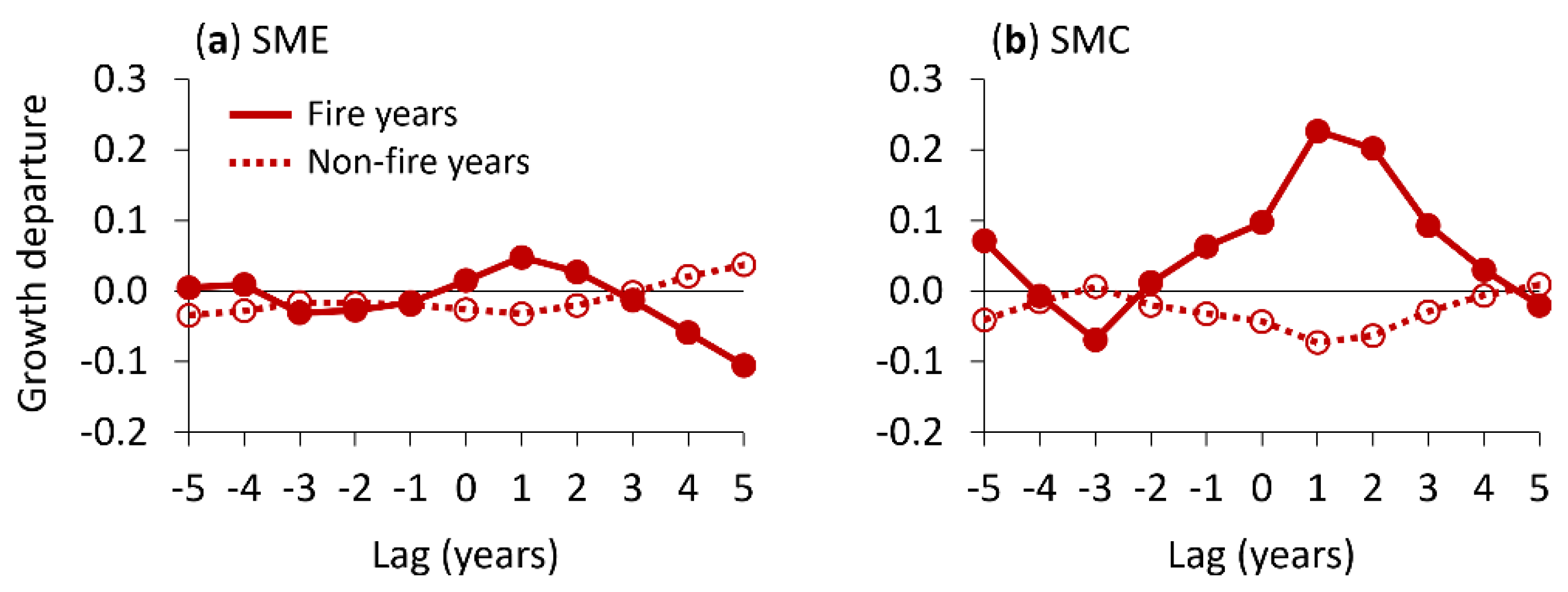Dwarf Blackgum (Nyssa sylvatica) Contains Datable Fire Scars that Complement an Existing Fire History
Abstract
1. Introduction
2. Materials and Methods
3. Results and Discussion
3.1. Blackgum Growth and Fire-Scar Data
3.2. Multi-Species Fire History (1954–2014)
4. Conclusions
Funding
Acknowledgments
Conflicts of Interest
Appendix A

References
- Little, E.L. Atlas of United States Trees, Volume 1. Conifers and Important Hardwoods; Miscellaneous Publication 1146; United State Department of Agriculture, Forest Service: Washington, DC, USA, 1971.
- United States Department of Agriculture, Natural Resources Conservation Service (NRCS). PLANTS Database. Available online: https://plants.usda.gov/ (accessed on 2 November 2019).
- Abrams, M.D. Tales from the blackgum, a consummate subordinate tree. BioScience 2007, 57, 347–359. [Google Scholar] [CrossRef]
- Harrod, J.C.; White, R.D. Age structure and radial growth in xeric pine-oak forests in western Great Smoky Mountains National Park. J. Torrey Bot. Soc. 1999, 126, 139–146. [Google Scholar] [CrossRef]
- Gemborys, S.R.; Hodgkins, E.J. Forests of small stream bottoms in the coastal plain of southwestern Alabama. Ecology 1971, 52, 70–78. [Google Scholar] [CrossRef]
- Doumlele, D.G.; Fowler, B.K.; Silberhorn, G.M. Vegetative community structure of a tidal freshwater swamp in Virginia. Wetlands 1984, 4, 129–145. [Google Scholar] [CrossRef]
- Burns, R.M.; Honkala, B.H. Silvics of North America, Volume 2: Hardwoods; Agricultural Handbook 654; United States Department of Agriculture: Washington, DC, USA, 1990.
- Harmon, M.E. Survival of trees after low-intensity surface fires in Great Smoky Mountains National Park. Ecology 1984, 65, 796–802. [Google Scholar] [CrossRef]
- Sperduto, D.D.; Nichols, W.F.; Crowley, K.F.; Bechtel, D.A. Black Gum (Nyssa sylvatica Marsh.) in New Hampshire; New Hampshire Natural Heritage Inventory, Department of Resources & Economic Development: Concord, NH, USA, 2000.
- Lafon, C.W.; Naito, A.T.; Grissino-Mayer, H.D.; Horn, S.P.; Waldrop, T.A. Fire History of the Appalachian Region: A Review and Synthesis; Gen. Tech. Rep. SRS-219; Southern Research Station USDA Forest Service: Asheville, NC, USA, 2017; pp. 1–97.
- Speer, J.H. Fundamentals of Tree-Ring Research; University of Arizona Press: Tucson, AZ, USA, 2010; ISBN 0816526850. [Google Scholar]
- Smith, K.T.; Sutherland, E.K. Terminology and biology of fire scars in selected central hardwoods. Tree Ring Res. 2001, 57, 141–147. [Google Scholar]
- Guyette, R.P.; Dey, D.C.; Stambaugh, M.C.; Muzika, R.M. Fire Scars Reveal Variability and Dynamics of Eastern Fire Regimes. In Proceedings of the Fire in Eastern Oak Forests Conference, Columbus, OH, USA, 15–17 November 2005; Gen. Tech. Rep. NRS-P-1. Dickinson, M.B., Ed.; USDA Forest Service, Northern Research Station: Newtown Square, PA, USA, 2006; pp. 20–39. [Google Scholar]
- Hart, J.L.; Buchanan, M.L. History of Fire in Eastern Oak Forests and Implications for Restoration. In Proceedings of the 4th Fire in Eastern Oak Forests Conference, Springfield, MO, USA, 17–19 May 2011; Gen. Tech. Rep. NRS-P-102. USDA Forest Service, Northern Research Station: Newtown Square, PA, USA; pp. 34–51. [Google Scholar]
- Silver, E.J.; Speer, J.H.; Kaye, M.; Reo, N.J.; Howard, L.F.; Anning, A.K.; Wood, S.W.; Wilbur, H.M. Fire history and age structure of an oakpine forest on Price Mountain, Virginia, USA. Nat. Areas J. 2013, 33, 440–446. [Google Scholar] [CrossRef]
- Fike, J. Terrestrial Palustrine Plant Communities of Pennsylvania; Pennsylvania Bureau of Forestry, Department of Conservation and Natural Resources: Harrisburg, PA, USA, 1999.
- United States Geological Survey. Conyngham Quadrangle, Pennsylvania. 7.5 Minute Series (Topographic Map); United States Geological Survey: Reston, VA, USA, 1949.
- Saladyga, T.; Standlee, A. Historical drivers and contemporary perceptions of wildfire in a post-industrial rural landscape. Fire 2018, 1, 33. [Google Scholar] [CrossRef]
- Saladyga, T. Reconstructing a cultural fire regime in the Pennsylvania Anthracite Region. Phys. Geogr. 2017, 38, 404–422. [Google Scholar] [CrossRef]
- Schweingruber, F.H.; Eckstein, D.; Serre-Bachet, F.; Bräker, O.U. Identification, presentation and interpretation of event years and pointer years in dendrochronology. Dendrochronologia 1990, 8, 9–38. [Google Scholar]
- Larsson, L.Å.C. CooRecorder/CDendro Package, version 8.1; Computer Software; Saltsjöbaden, Sweden. 2016.
- Holmes, R.L. Computer assisted quality control in tree-ring dating and measurement. Tree Ring Bull. 1983, 43, 69–78. [Google Scholar]
- Brewer, P.W.; Velásquez, M.E.; Sutherland, E.K.; Falk, D.A. Fire History Analysis and Exploration System. (FHAES), version 2.0.2; Computer Software; 2016. Available online: http://www.fhaes.org (accessed on 7 October 2019).
- Orwig, D.A.; Abrams, M.D. Contrasting radial growth and canopy recruitment patterns in Liriodendron tulipifera and Nyssa sylvatica: Gap-obligate versus gap-facultative tree species. Can. J. For. Res. 1994, 24, 2141–2149. [Google Scholar] [CrossRef]
- Abrams, M.D.; Copenheaver, C.A.; Black, B.A.; Gevel, S.V.D. Dendroecology and climatic impacts for a relict, old-growth, bog forest in the Ridge and Valley Province of central Pennsylvania, USA. Can. J. Bot. 2001, 79, 58–69. [Google Scholar] [CrossRef]
- Marschall, J.; Stambaugh, M.; Jones, B.; Guyette, R.; Brose, P.; Dey, D. Fire regimes of remnant pitch pine communities in the Ridge and Valley region of central Pennsylvania, USA. Forests 2016, 7, 224. [Google Scholar] [CrossRef]
- Dinh, T.; Hewitt, N.; Drezner, T.D. Fire history reconstruction in the black oak (Quercus velutina) savanna of High Park, Toronto. Nat. Areas J. 2015, 35, 468–475. [Google Scholar] [CrossRef][Green Version]
- Burns, R.M.; Honkala, B.H. Silvics of North America, Volume 1: Conifers; Agricultural Handbook 654; United States Department of Agriculture: Washington, DC, USA, 1990.
- Kurilla, R.; (Forest District 18, Assistant District Forester, Pennsylvania Bureau of Forestry, Ebensburg, PA, USA). Personal communication, 2016.




| Sample ID | Site | Inner-Ring Year | Outer-Ring Year | Ring Width (mm) 1 | Correlation with Master Chronology (r) | Fire Year(s) 2 |
|---|---|---|---|---|---|---|
| SPMT14 | SMC | 1955 | 2014 | 2.08 ± 1.10 | 0.45 | 2004, 2005 |
| SPMT16 | SMC | 1919 | 2013 | 1.10 ± 0.55 | 0.32 | 1986 |
| SPMT19 | SMC | 1954 | 2014 | 1.90 ± 0.98 | 0.52 | 1977, 1978, 1993, 1999, 2006 |
| SPMT20 | SMC | 1957 | 2013 | 1.56 ± 0.86 | 0.51 | 1992, 1997 |
| SPMT21 | SMC | 1954 | 2013 | 1.46 ± 0.79 | 0.40 | 1985, 1992, 2007 |
| SPMT22 | SMC | 1971 | 2014 | 2.32 ± 1.26 | 0.57 | 1983, 1985, 1992, 1998, 1999, 2000 |
| SPMT24 | SMC | 1955 | 2014 | 1.17 ± 0.50 | 0.36 | 2003 |
| SPMT27 | SMC | 1956 | 2014 | 1.84 ± 0.72 | 0.55 | 1993 |
| SPMT45 | SMW | 1958 | 2014 | 2.10 ± 0.84 | 0.64 | 1986 |
| SPMT57 | SME | 1964 | 2014 | 2.05 ± 0.67 | 0.54 | 1990, 2003 |
| SPMT58 | SME | 1970 | 1997 | 3.19 ± 1.11 | 0.38 | 1986, 1993, 1995 |
| SPMT59 | SME | 1962 | 2012 | 1.67 ± 1.44 | 0.18 | 1999, 2004, 2007, 2009, 2012 |
| SPMT60 | SME | 1972 | 2014 | 2.96 ± 1.36 | 0.27 | 1993, 1999, 2005, 2009 |
| SPMT61 | SME | 1969 | 2013 | 1.54 ± 0.77 | 0.24 | 1998, 2002, 2008 |
| SPMT62 | SME | 1954 | 2014 | 1.53 ± 0.69 | 0.47 | 1993, 2000 |
| SPMT63 | SME | 1955 | 2014 | 1.31 ± 0.72 | 0.43 | 2006, 2008 |
| SPMT64 | SME | 1961 | 2014 | 1.53 ± 0.58 | 0.25 | 1979, 1997, 2004, 2005, 2006 |
| Fire year 1 | Site | Species | Fire Scars | Trees Scarred (%) |
|---|---|---|---|---|
| 1954 | SME | Pitch pine | 5 | 62.5 |
| SMC | Pitch pine | 3 | 21.4 | |
| SMW | Pitch pine | 6 | 46.2 | |
| 1956 | SME | Pitch pine | 2 | 25.0 |
| 1976 | SMC | Pitch pine | 2 | 11.8 |
| 1982 | SMC | Pitch pine | 2 | 11.8 |
| 1985 | SMC | Blackgum | 2 | 25.0 |
| 1991 | SME | Pitch pine | 3 | 21.4 |
| 1992 | SME | Pitch pine | 3 | 21.4 |
| SMC | Blackgum | 3 | 37.5 | |
| 1993 | SME | Blackgum | 3 | 37.5 |
| SMC | Blackgum | 2 | 25.0 | |
| SMC | Sassafras | 5 | 71.4 | |
| SMW | Sassafras | 2 | 100.0 | |
| 1996 | SMC | Sassafras | 2 | 28.6 |
| 1999 | SME | Blackgum | 2 | 28.6 |
| SMC | Blackgum | 2 | 25.0 | |
| 2000 | SMC | Sassafras | 2 | 28.6 |
| 2004 | SME | Blackgum | 2 | 28.6 |
| 2005 | SME | Blackgum | 2 | 28.6 |
| SME | Pitch pine | 2 | 14.3 | |
| SMC | Sassafras | 2 | 28.6 | |
| 2006 | SME | Blackgum | 2 | 28.6 |
| 2008 | SME | Blackgum | 2 | 28.6 |
| 2009 | SME | Blackgum | 2 | 28.6 |
| 2012 | SMC | Sassafras | 3 | 42.9 |
| 2014 | SMC | Sassafras | 5 | 71.4 |
© 2019 by the author. Licensee MDPI, Basel, Switzerland. This article is an open access article distributed under the terms and conditions of the Creative Commons Attribution (CC BY) license (http://creativecommons.org/licenses/by/4.0/).
Share and Cite
Saladyga, T. Dwarf Blackgum (Nyssa sylvatica) Contains Datable Fire Scars that Complement an Existing Fire History. Fire 2019, 2, 61. https://doi.org/10.3390/fire2040061
Saladyga T. Dwarf Blackgum (Nyssa sylvatica) Contains Datable Fire Scars that Complement an Existing Fire History. Fire. 2019; 2(4):61. https://doi.org/10.3390/fire2040061
Chicago/Turabian StyleSaladyga, Thomas. 2019. "Dwarf Blackgum (Nyssa sylvatica) Contains Datable Fire Scars that Complement an Existing Fire History" Fire 2, no. 4: 61. https://doi.org/10.3390/fire2040061
APA StyleSaladyga, T. (2019). Dwarf Blackgum (Nyssa sylvatica) Contains Datable Fire Scars that Complement an Existing Fire History. Fire, 2(4), 61. https://doi.org/10.3390/fire2040061





